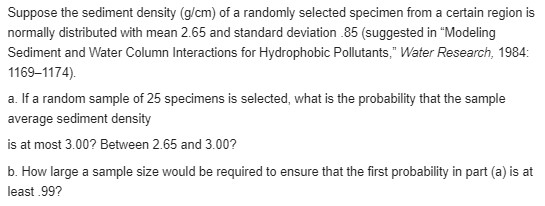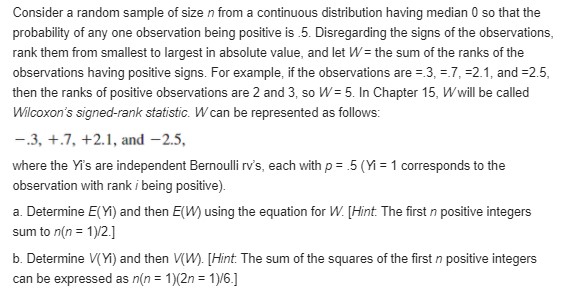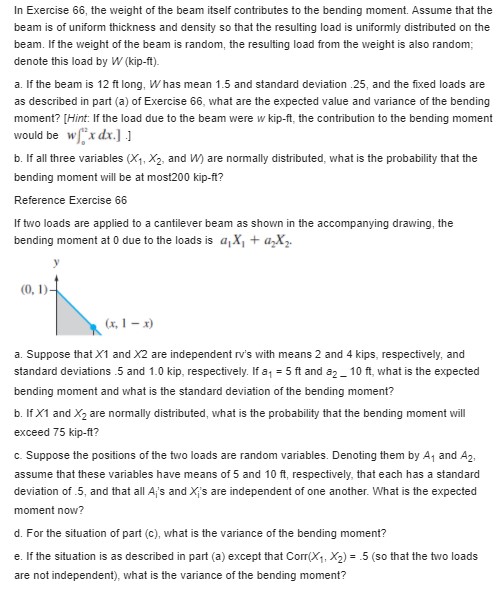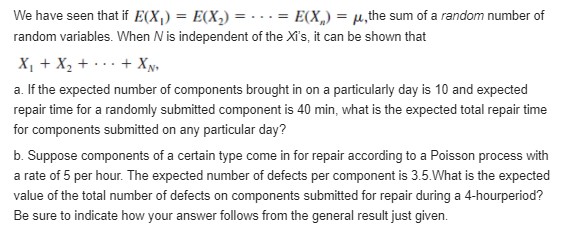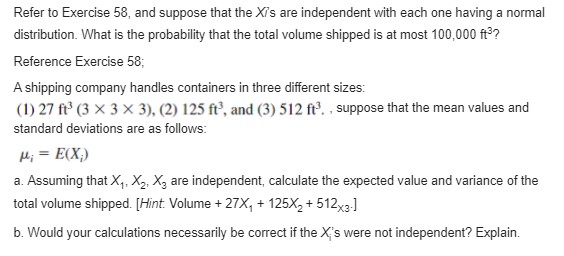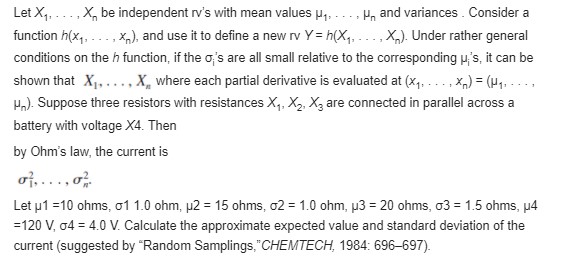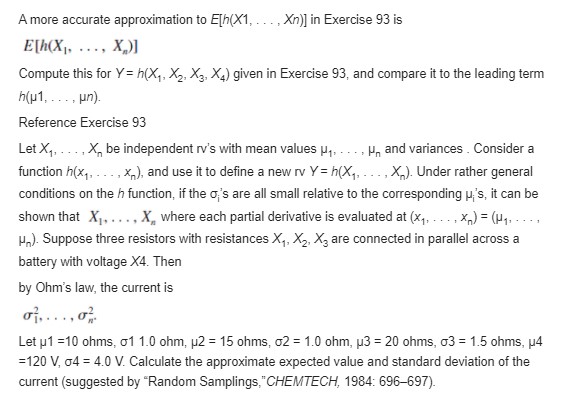solve these practice problems
Suppose the sediment density (g/cm) of a randomly selected specimen from a certain region is normally distributed with mean 2.65 and standard deviation .85 (suggested in "Modeling Sediment and Water Column Interactions for Hydrophobic Pollutants," Water Research, 1984: 1169-1174). a. If a random sample of 25 specimens is selected, what is the probability that the sample average sediment density is at most 3.00? Between 2.65 and 3.00? b. How large a sample size would be required to ensure that the first probability in part (a) is at least .99?A binary communication channel transmits a sequence of "bits" (0s and 1s). Suppose that for any particular bit transmitted, there is a 10% chance of a transmission error (a 0 becoming a 1 or a 1 becoming a 0). Assume that bit errors occur independently of one another. a. Consider transmitting 1000 bits. What is the approximate probability that at most 125 transmission errors occur? b. Suppose the same 1000-bit message is sent two different times independently of one another. What is the approximate probability that the number of errors in the first transmission is within 50 of the number of errors in the second?Consider a random sample of size n from a continuous distribution having median 0 so that the probability of any one observation being positive is .5. Disregarding the signs of the observations, rank them from smallest to largest in absolute value, and let W= the sum of the ranks of the observations having positive signs. For example, if the observations are =.3, =.7, =2.1, and =2.5, then the ranks of positive observations are 2 and 3, so W= 5. In Chapter 15, Wwill be called Wilcoxon's signed-rank statistic. W can be represented as follows: -.3, +.7. +2.1, and -2.5, where the Vi's are independent Bernoulli rv's, each with p = .5 (Yi = 1 corresponds to the observation with rank / being positive). a. Determine E(Yi) and then E(W) using the equation for W. [Hint. The first n positive integers sum to n(n = 1)/2.] b. Determine V(Yi) and then V(W). [Hint: The sum of the squares of the first n positive integers can be expressed as n(n = 1)(2n = 1)/6.]In Exercise 66, the weight of the beam itself contributes to the bending moment. Assume that the beam is of uniform thickness and density so that the resulting load is uniformly distributed on the beam. If the weight of the beam is random, the resulting load from the weight is also random; denote this load by W (kip-ft). a. If the beam is 12 ft long, Whas mean 1.5 and standard deviation .25, and the fixed loads are as described in part (a) of Exercise 66, what are the expected value and variance of the bending moment? [Hint: If the load due to the beam were w kip-ft, the contribution to the bending moment would be w xdx.] ] b. If all three variables (X1, X2, and W) are normally distributed, what is the probability that the bending moment will be at most200 kip-ft? Reference Exercise 66 If two loads are applied to a cantilever beam as shown in the accompanying drawing, the bending moment at 0 due to the loads is a, X, + a,X2. (0, 1)- (x, 1 - x) a. Suppose that X1 and X2 are independent rv's with means 2 and 4 kips, respectively, and standard deviations .5 and 1.0 kip, respectively. If a, = 5 ft and a2 _ 10 ft, what is the expected bending moment and what is the standard deviation of the bending moment? b. If X1 and X2 are normally distributed, what is the probability that the bending moment will exceed 75 kip-ft? c. Suppose the positions of the two loads are random variables. Denoting them by A, and A2, assume that these variables have means of 5 and 10 ft, respectively, that each has a standard deviation of .5, and that all Aj's and Xi's are independent of one another. What is the expected moment now? d. For the situation of part (c), what is the variance of the bending moment? e. If the situation is as described in part (a) except that Corr(X,, X2) = .5 (so that the two loads are not independent), what is the variance of the bending moment?We have seen that if E(X ) = E(X,) = . . . = E(X ) = u, the sum of a random number of random variables. When / is independent of the Xi's, it can be shown that X +X2 + . .. + XN. a. If the expected number of components brought in on a particularly day is 10 and expected repair time for a randomly submitted component is 40 min, what is the expected total repair time for components submitted on any particular day? b. Suppose components of a certain type come in for repair according to a Poisson process with a rate of 5 per hour. The expected number of defects per component is 3.5.What is the expected value of the total number of defects on components submitted for repair during a 4-hourperiod? Be sure to indicate how your answer follows from the general result just given.Refer to Exercise 58, and suppose that the X/'s are independent with each one having a normal distribution. What is the probability that the total volume shipped is at most 100,000 ft-? Reference Exercise 58; A shipping company handles containers in three different sizes: (1) 27 ft (3 X 3 x 3), (2) 125 ft, and (3) 512 f13. , suppose that the mean values and standard deviations are as follows: H; = E(X;) a. Assuming that X, X2, X, are independent, calculate the expected value and variance of the total volume shipped. [Hint. Volume + 27X, + 125X, + 512x3.] b. Would your calculations necessarily be correct if the X's were not independent? Explain.Let X,, . .. . X, be independent rv's with mean values p., ..., J. and variances . Consider a function h(x,, . . ., x ), and use it to define a new rv Y = h(X, .. ., X ). Under rather general conditions on the / function, if the o's are all small relative to the corresponding p;'s, it can be shown that X. .. .. X where each partial derivative is evaluated at (x, , . . ., x ) = (H, . . . . u ). Suppose three resistors with resistances X,, X, X, are connected in parallel across a battery with voltage X4. Then by Ohm's law, the current is of. . . ..02. Let p1 =10 ohms, 01 1.0 ohm, p2 = 15 ohms, 02 = 1.0 ohm, p3 = 20 ohms, 03 = 1.5 ohms, u4 =120 V, 04 = 4.0 V. Calculate the approximate expected value and standard deviation of the current (suggested by "Random Samplings,"CHEMTECH, 1984: 696-697).A more accurate approximation to E[h[X1, _ _ _ , 331]] in Exercise 93 is Eifl, .. . , I,\" Compute this for Y: hm}, X2, X3, X4] given in Exercise 93, and compare it to the leading term h{u1 _____ on]. Reference Exercise 93 Let X1, . . . , A; be independent rv'swith mean values pl, . . . , \"n and variances . Consider a function h[x1, . . . x l, and use it to dene a new rv Y: h[X,, . . . , Xn]. Under rather general " Fl oonritions on the h function, it the dis are all small relative to the corresponding pi's, it can be shown that X] ..... I, where each partial derivative is evaluated at {1:1 ..... In} = {p1 _____ [1"]. Suppose three resistors with resistances X1, X2, X3 are connected in parallel across a battery with voltage X4. Then by Ohm's law, the current is sinus}, Let p1=1l] ohms, G1 11} ohm, u2 = 15 ohms, o2 =1.l] ohm, p3 = 20 ohms, o3 = 1.5 ohms, p4 =12 in", 54 = 4.!) 'v". Calculate the approximate expected value and standard deviation of the current [suggested by \"Random Samplings,"EH-iE-H'ECH 1984'. ESE69?]. Reconsider the minicomputer component lifetimes X and Y as described in Exercise 12. Determine E(XY). What can be said about Cov(X, Y) and p? Reference exercise 12 Two components of a minicomputer have the following joint pdf for their useful lifetimes X and Y: f(x, y) xe *(1+>) x 2 0 andy 2 0 0 otherwise a. What is the probability that the lifetime X of the first component exceeds 3? b. What are the marginal pdf's of X and Y? Are the two lifetimes independent? Explain. c. What is the probability that the lifetime of at least one component exceeds 3?Use the result of Exercise 28 to show that when X and Y are independent, Cov(X, Y) = Com(X, Y) = 0. Reference exercise 28 Show that if X and Y are independent rv's, then E(XY) = E(X) . E(Y). Then apply this in Exercise 25. [Hint: Consider the continuous case with f(x, y) = fX(x) . fy (V).] Reference exercise 25 A surveyor wishes to lay out a square region with each side having length L. However, because of a measurement error, he instead lays out a rectangle in which the north-south sides both have length X and the east-west sides both have length Y. Suppose that X and Y are independent and that each is uniformly distributed on the interval [L-A, L+A] (where 0
